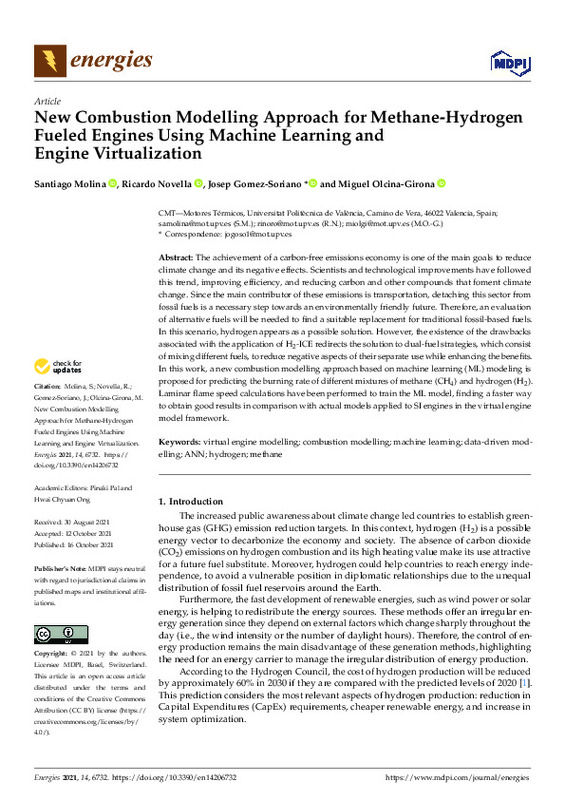JavaScript is disabled for your browser. Some features of this site may not work without it.
Buscar en RiuNet
Listar
Mi cuenta
Estadísticas
Ayuda RiuNet
Admin. UPV
New Combustion Modelling Approach for Methane-Hydrogen Fueled Engines Using Machine Learning and Engine Virtualization
Mostrar el registro sencillo del ítem
Ficheros en el ítem
| dc.contributor.author | Molina, Santiago
|
es_ES |
| dc.contributor.author | Novella Rosa, Ricardo
|
es_ES |
| dc.contributor.author | Gómez-Soriano, Josep
|
es_ES |
| dc.contributor.author | Olcina-Girona, Miguel
|
es_ES |
| dc.date.accessioned | 2022-05-13T18:05:48Z | |
| dc.date.available | 2022-05-13T18:05:48Z | |
| dc.date.issued | 2021-11 | es_ES |
| dc.identifier.uri | http://hdl.handle.net/10251/182599 | |
| dc.description.abstract | [EN] The achievement of a carbon-free emissions economy is one of the main goals to reduce climate change and its negative effects. Scientists and technological improvements have followed this trend, improving efficiency, and reducing carbon and other compounds that foment climate change. Since the main contributor of these emissions is transportation, detaching this sector from fossil fuels is a necessary step towards an environmentally friendly future. Therefore, an evaluation of alternative fuels will be needed to find a suitable replacement for traditional fossil-based fuels. In this scenario, hydrogen appears as a possible solution. However, the existence of the drawbacks associated with the application of H-2-ICE redirects the solution to dual-fuel strategies, which consist of mixing different fuels, to reduce negative aspects of their separate use while enhancing the benefits. In this work, a new combustion modelling approach based on machine learning (ML) modeling is proposed for predicting the burning rate of different mixtures of methane (CH4) and hydrogen (H2). Laminar flame speed calculations have been performed to train the ML model, finding a faster way to obtain good results in comparison with actual models applied to SI engines in the virtual engine model framework. | es_ES |
| dc.language | Inglés | es_ES |
| dc.publisher | MDPI AG | es_ES |
| dc.relation.ispartof | Energies | es_ES |
| dc.rights | Reconocimiento (by) | es_ES |
| dc.subject | Virtual engine modelling | es_ES |
| dc.subject | Combustion modelling | es_ES |
| dc.subject | Machine learning | es_ES |
| dc.subject | Data-driven modelling | es_ES |
| dc.subject | ANN | es_ES |
| dc.subject | Hydrogen | es_ES |
| dc.subject | Methane | es_ES |
| dc.subject.classification | MAQUINAS Y MOTORES TERMICOS | es_ES |
| dc.subject.classification | INGENIERIA AEROESPACIAL | es_ES |
| dc.title | New Combustion Modelling Approach for Methane-Hydrogen Fueled Engines Using Machine Learning and Engine Virtualization | es_ES |
| dc.type | Artículo | es_ES |
| dc.identifier.doi | 10.3390/en14206732 | es_ES |
| dc.rights.accessRights | Abierto | es_ES |
| dc.contributor.affiliation | Universitat Politècnica de València. Departamento de Máquinas y Motores Térmicos - Departament de Màquines i Motors Tèrmics | es_ES |
| dc.description.bibliographicCitation | Molina, S.; Novella Rosa, R.; Gómez-Soriano, J.; Olcina-Girona, M. (2021). New Combustion Modelling Approach for Methane-Hydrogen Fueled Engines Using Machine Learning and Engine Virtualization. Energies. 14(20):1-21. https://doi.org/10.3390/en14206732 | es_ES |
| dc.description.accrualMethod | S | es_ES |
| dc.relation.publisherversion | https://doi.org/10.3390/en14206732 | es_ES |
| dc.description.upvformatpinicio | 1 | es_ES |
| dc.description.upvformatpfin | 21 | es_ES |
| dc.type.version | info:eu-repo/semantics/publishedVersion | es_ES |
| dc.description.volume | 14 | es_ES |
| dc.description.issue | 20 | es_ES |
| dc.identifier.eissn | 1996-1073 | es_ES |
| dc.relation.pasarela | S\448041 | es_ES |








